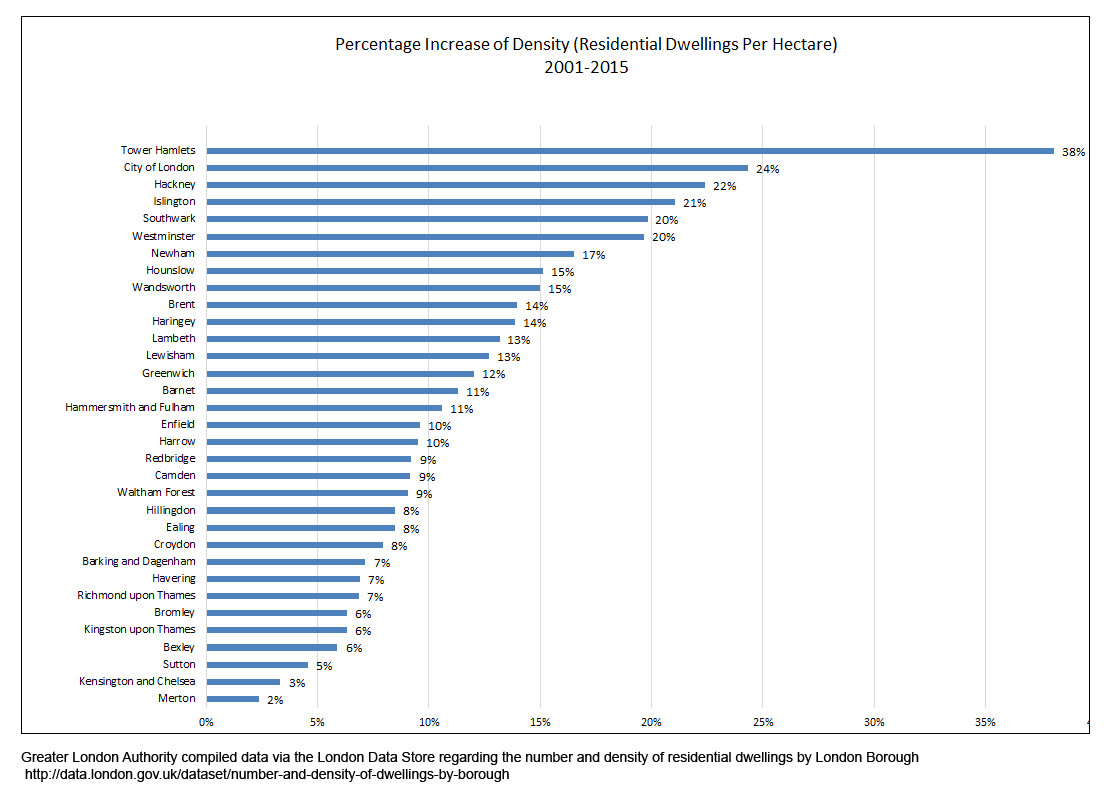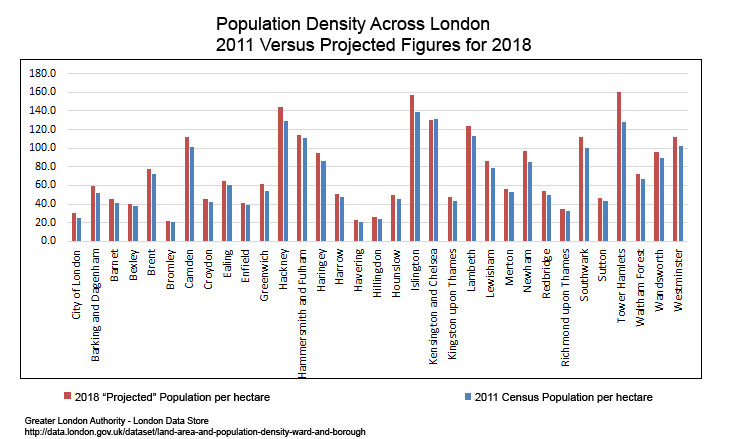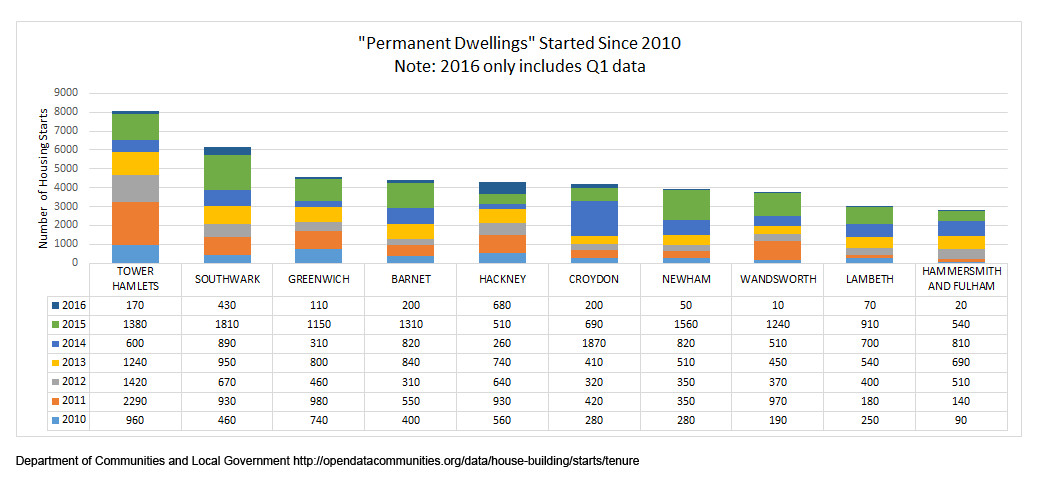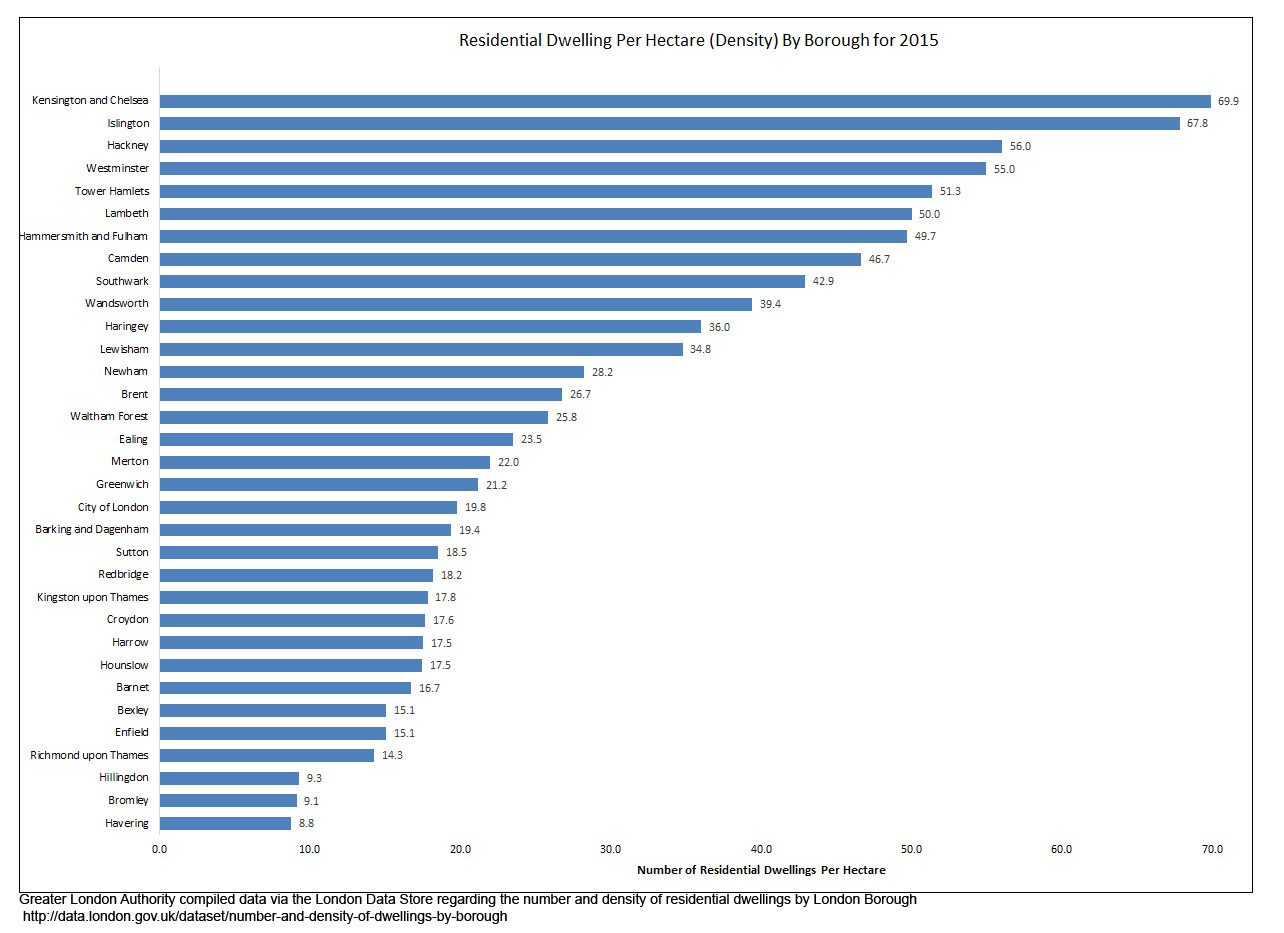Surge in Population and New Builds in Tower Hamlets
1 September 2016 - Analysis
See also Blog Entry: 5 Tips for Pitching Low Offers
See also 1 Sept 2016 - New Builds Flooding Market in Some Boroughs
Summary
- Tower Hamlets has been the fastest growing London borough with a 38 percent increase in the concentration of residential dwellings. From 2001 to 2015, Tower Hamlets moved from number 8 to number 5 in the ranking of number of dwellings per hectare - a measure of the density of residential dwellings.
- By 2018, Tower Hamlets could overtake Islington to become the most-densely populated borough in London, according to forecasts from the Greater London Authority.
- Data suggests that Tower Hamlets has seen the commencement of over 8,000 new residential dwellings (Building Starts) from 2010 to 2016. The construction of new residential dwellings in this borough exceeds all other boroughs in London.
- The growth shows little signs of abating, as on average, Tower Hamlets takes decisions on 35.5 Major residential planning applications per year. Just last year, 32 major residential planning applications decisions were taken with a 91 percent approval rate. Compare this to Kensington and Chelsea were only 13 Major residential planning application decisions were taken last year.
- In September 2016, one in three properties listed for sale in Tower Hamlets was a new home.
Tower Hamlets is emerging as one of the fastest-growing London boroughs in terms of residential dwelling and population density as suggested by data released by Greater London Authority and the Department for Communities and Local Government.
Tower Hamlets has experienced a 38 percent increase in residential dwellings over the past 14 years. The Greater London Authority is forecasting Tower Hamlets to become the most densely-populated London borough within 2 years. The number of planning applications for major residential developments continue at above-average figures with high approval rates. Whilst the research by Propcision does not individually consider each approved major development, the figures alone indicate a robust flow of interest in creating more homes in the borough.
In September 2016, one in three properties listed for sale was noted as a “new home” suggesting that newly-completed homes are filtering through the property market.
House prices and rental yields within Tower Hamlets could move downward under pressure from the volume of new builds listed for sale and areas of the borough being correlated with the financial industry.
Concentration of Residential Dwellings and Population
Kensington and Chelsea was noted as the London borough having the most residential dwellings per hectare - thus the highest concentration of homes, according to figures released by Greater London Authority. Data from 2001-2015 shows it has held the top position for 14 years. However, during that time, the borough’s density only increased by 3 percent - thereby making it the second slowest growing borough in terms of residential dwellings density.
In the same period, Tower Hamlets increased by 38 percent making it the fastest-growing borough in terms of the concentration of homes. This is well above the average increase in density of 12 percent for all of London for the same time period.
Tower Hamlets is now ranked 5th amongst London boroughs - rising from 8th in 2001.
Ranking by Residential Dwelling Density per Hectare (Top 5)
source: http://data.london.gov.uk/dataset/number-and-density-of-dwellings-by-borough
Year 2015 |
Year 2001 |
Kensington and Chelsea |
Kensington and Chelsea |
Islington |
Islington |
Hackney |
Westminster |
Westminster |
Hackney |
Tower Hamlets |
Hammersmith and Fulham |
|
|

Population Density
Whilst residential density figures provide a picture of residential housing, population density provides a picture of how crowded a borough might be.
Islington has the highest population density of London with 15,118 people per square kilometre according to the Greater London Authority. Tower Hamlets has the second highest population density with 14,514 people per square kilometre. By 2018, the Greater London Authority is forecasting that Tower Hamlets would have grown 24 percent from the official 2011 population figures recorded for the borough and overtake Islington to become the most densely-populated borough in London.
Interestingly, the same data is forecasting that Kensington and Chelsea’s population density will shrink by 1% by 2017 and beyond. As mentioned above, this borough has already been noted as one of the slowest growing boroughs in terms of residential dwelling density. Thus, these forecasts appear to align with the slow change in residential density over the past years.
The chart below illustrates the official 2011 population density figures against the Greater London Authority’s 2018 forecasted figures.

Housing Starts – A look towards new residential developments
Housing starts figures reflect the number of privately-owned new residential units on which the foundation has been laid. Figures capture the number of dwellings officially under construction. It provides an early indicator of the number of new residential dwellings to be made available in the next few years when the construction is completed.
From 2010 to 2016, Tower Hamlets has seen the commencement of over 8,000 new residential dwellings (Building Starts), according to Housing Starts data from Department of Communities and Local Government. The construction of new residential dwellings in this area exceeds all other boroughs in London.

Planning Applications
Planning application “approval rates” and the specific developments approved could provide an indication into district-level planning and the possible transformation of an area. Specifically, planning applications defined as "major residential planning applications" are useful in predicting possible activity and growth in area. A "major residential development" is a development where the number of residential units to be constructed is 10 or more.
According to statistics compiled by Department for Communities and Local Government, only 13 major residential planning application decisions were taken by Kensington and Chelsea in year ending March 2016 - all were approved. On average, since 2009, 9 Major residential planning application decisions are taken by the Borough per year.
Compare this against Tower Hamlets, where 32 major residential planning applications decisions were taken last year, with a 91 percent approval rate. On average, over the past 6 years, Tower Hamlets takes decisions on 35.5 major residential planning applications per year. In 2012, Tower Hamlet’s approval rating for major residential planning applications was 96 percent. In that year, data suggests the borough approved 52 major residential planning applications.
Future of House Prices in Tower Hamlets
New housing stock has increased dramatically within a short period of time potentially making Tower Hamlets more sensitive to house price pressure. Due to links to the financial industry, in the event of further economic weakening, the effects to the housing market in Tower Hamlets could be felt more acutely.
In September 2016, one in three properties listed for sale in Tower Hamlets was classified as a “new home”. Compare this to Kensington and Chelsea where one in twelve properties listed for sale was classified as a “new home”. If demand in this area wanes and stock continues to increase, then competition amongst new-build stock could become fierce and could lead to further price reductions across the borough.
